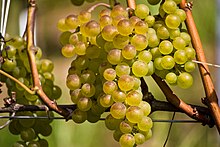Bianca (grape)
| Bianca | |
|---|---|
| Grape (Vitis) | |
 Bianca grapes ripening on the vine | |
| Species | Vitis vinifera |
| VIVC number | 1321 |
Bianca is a white
grapevines.[1]
History
Bianca was developed in 1963 at the
selfling of Villard blanc). The grape was originally named Egri Csillagok 40 meaning "star of Eger" with 40 being a breeding code but was officially registered under the name Bianca when it was authorized for wine production in 1982.[1]
In
Serbia, Bianca was crossed with Petra to create two different pink-berried wine grape varieties, Bačka and Rubinka, which have been authorized for use in wine production since 2002.[1]
Viticulture

Bianca is an early to mid
growing seasons.[1]
The grape clusters of Bianca tend to be medium-sized to very large but the berries tend always be small in size with a noticeable waxy coating. The grapevine has strong resistance to many fungal diseases that can infect grapevines which has contributed to Bianca's popularity among organic vine growers. The vine can also be very vigorous, producing a large leafy
flowering.[1]
Wine regions
As of 2012, there were 1,280 hectares (3,200 acres) of Bianca planted in Hungary, the vast majority in the
Moldova, there were 15 hectares (37 acres) of Bianca being used in wine production as of 2012.[1]
Styles

According to
oxidation with care needing to be taken to avoid the development of wine faults.[1]
Synonyms
Over the years, Bianca has been known under a variety of synonyms including: Biahka, Bianka, EC 40, ECS 40, Egri Csillagok 40 and May Rot.[2]
References
- ^ ISBN 978-1-846-14446-2
- ^ Vitis International Variety Catalogue (VIVC) Bianca Archived 2014-02-03 at the Wayback Machine Accessed: June 11th, 2014
